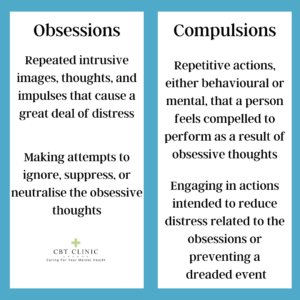
Pure O – All The Facts You Need To Know
Pure O – All The Facts You Need To Know
Purely Obsessional OCD, or Pure O as it’s more commonly referred to, is a form of OCD (Obsessive Compulsive Disorder) characterised by intrusive, uncontrollable thoughts or obsessions. Although someone experiencing Pure O may not display the more obvious behaviours associated with OCD such as hand-washing, arranging, cleaning and counting, the disorder is instead accompanied by hidden mental rituals.
Pure O is often seen as a less severe form of OCD however that is far from correct. For those experiencing the symptoms of Pure O, the intrusive thoughts that present can be extremely disruptive and distressing.
How Does Pure O differ from OCD?
Those with Puro O experience obsessions without any obvious behavioural compulsions however, they do still engage in mental and unseen rituals. By therapists and mental health professionals understanding these rituals and how they affect sufferers, they can then ask patients about these symptoms.
Often patients with these intrusive thoughts may be reluctant to discuss this and may not actually be aware that by acknowledging them, they can begin to take control of them.
What Are the Symptoms of Pure O?
The nature of Obsessive Compulsive Disorder means having recurring obsessions and displaying compulsive behaviours e.g having uncontrollable thoughts of germs and cleanliness which results in a com[pulsion to wash their hands repeatedly.
Those who experience OCD in a purely obsessional form still encounter a range of OCD symptoms however the outwardly obvious compulsions aren’t displayed. By definition, OCD is characterised by obsessions and compulsions. With Pure O these can be identified in the image below.

What Are Obsessions?
Obsessions can be described as recurring, persistent, intrusive and unwanted thoughts, images or urges which cause distress and anxiety. Obsessions often focus on somatic (related to the body), sexual, religious or aggressive thoughts. Concerns with symmetry, order and contamination can also be present.
What Are Compulsions?
Compulsions are repetitive behaviours or mental acts those with OCD are compelled to perform as a response to an obsession or perhaps, to satisfy a set of rules that govern their thoughts. Compulsions are excessive in comparison to typical reactions to thoughts and not connected realistically to the issue they’re intended to solve.
What Compulsions Are Associated with Pure O?
Intrusive thoughts may also be described as “unacceptable thoughts” or “taboo thoughts” which lead to obsessions and therefore compulsions. Individuals who experience Pure O obsessions engage in mental rituals in order to manage their distress and anxiety. These rituals could include:
- Mentally repeating certain words
- Mentally reviewing memories or information
- Mentally un-doing certain actions
As an example, a simple interaction at a supermarket with a stranger where the patient has mispronounced a word may be played out over and over mentally, with those experiencing this thought, thinking of how the situation would have gone differently if they hadn’t misspoken.
Those in distress by intrusive thoughts may then compulsively seek reassurance, most usually without realising that they are doing this or recognising it as a compulsion. Reassurance-seeking behaviour could look like:
- Researching online
- Seeking self-assurance
- Asking others for assurance
- Avoiding anxiety-provoking situations
Types of OCD
It’s thought that there may be three to six subtypes of OCD including Pure O. When it was first spoken of in a 1994 article (Journal of Clinical Psychiatry, Pure O was described as being composed of “sexual, aggressive and religious obsession that were not accompanied by compulsions”. However, later research went on to further divide aggressive obsession into fears of impulsive harm and unintentional harm. These thoughts of impulsive harm are often related to sex, religion and aggression.
Some common types of OCD experienced by patients with Pure O could include:
Harm OCD: Fears of causing harm to oneself or another including physical harm such as aggression towards or killing oneself or others and sexual harm including sexual harm towards children.
Intrusions about children OCD: Unwanted thoughts of a sexual nature and urges related to children. These can be accompanied by compulsive rituals for example washing or praying to neutralise the thoughts and urges.
Relationship OCD: Intrusive and unwanted thoughts which cause people to doubt their feelings within the relationship including the level of attraction and love for the partner as well as question their sexual desirability or compatibility.
Sexual Orientation obsession in OCD: This can also be called HODC or homosexual OCD Extreme anxiety about sexual orientation.
Treatment for Pure O and OCD
Treatment for OCD, including pure O, can include the use of medication in combination with psychotherapy, which can include cognitive behavioural therapy (CBT) and support groups as well as psychological education.
It has been discovered that CBT therapy can be an extremely effective treatment for Pure O. It is vital that therapists address the underlying mental rituals that characterise Pure O, if the therapist believes that the patient only suffers from obsessions and does not also treat the mental rituals that accompany these thoughts, the treatment will not be as effective.
Although successful treatment of OCD should entail consulting with a qualified mental health professional, there are a number of self-help strategies that you can start using before you start professional treatment to help you or someone you love to cope with pure O symptoms.
Relaxation strategies: As stress is a major trigger of pure O symptoms, one of the best ways to cope is to learn and practise relaxation techniques such as deep breathing, mindfulness meditation, or progressive muscle relaxation.
Exercise: There is growing evidence that engaging in aerobic exercise can reduce the symptoms of OCD. Exercise helps to release endorphins which are our happy hormones so is an important aspect of our daily mental health, exercising outdoors can be even more beneficial.
Support groups: Both online and in-person support groups can be of enormous benefit to people with pure O and their loved ones by providing resources, information, or simply a compassionate, listening ear.
If you or a loved one are suffering from Pure O, contact your healthcare provider and seek advice. They will provide you with a treatment plan as well as ongoing support and resources.
CBT Therapy London
Alistair Bond is principal practitioner at CBT Clinic London. As well as being an expert in CBT therapy and Mindfulness Meditation he specialises in OCD and helping people overcome distressing and upsetting Intrusive Thoughts- what is referred to in the media now as “Pure O”
The CBT Clinic London offers both online and face-to-face CBT Therapy. Just tell us which you’d prefer at your FREE consultation. If you’d like to mix the types of sessions you have, we also have that option. If you choose one type of session and decide you’d like to try another format, you have the freedom to change. Your therapy should be your way and led by you.
Contact us today to arrange your FREE Consultation. Call our friendly reception on 0207 157 9924 or fill out this form:
Related Posts
Online CBT Therapy – Everything You Need To Know
Online CBT Therapy – Everything You Need To Know Online CBT Therapy is the...
CBT Therapy Treatment for Intrusive Thoughts
Cognitive Behavioural Therapy (CBT therapy) Treatment for Intrusive Thoughts or...
Pure O – All The Facts You Need To Know
Pure O - All The Facts You Need To Know Purely Obsessional OCD, or Pure O as...
How Common is Depression?
Depression CBT Therapy East London Canary Wharf Despite the fact that...




